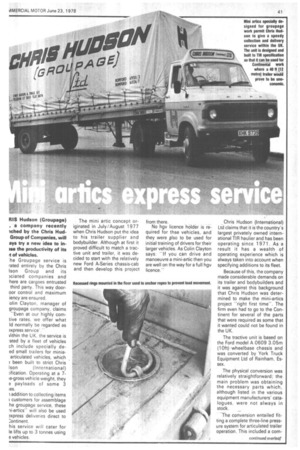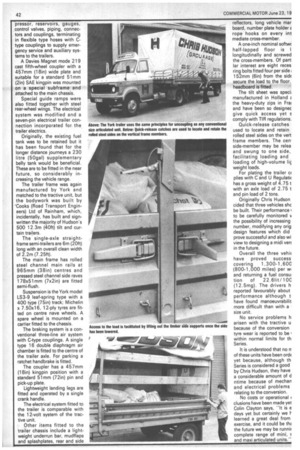New Essolube XD-3 15W/40 multigrade
Page 42

Page 43

Page 44

If you've noticed an error in this article please click here to report it so we can fix it.
Proven over millions of miles
RIS Hudson (Groupage) , a company recently iched by the Chris HudGroup of Companies, will ays try a new idea to inn° the productivity of its I of vehicles.
he Groupage service is rated entirely by the Chris !son Group and its )ciated companies and here are cargoes entrusted third party. This way dooroor control and maximum iency are ensured.
olin Clayton, manager of groupage company, claims "Even at our highly cornlive rates, we offer what Id normally be regarded as ?xpress service' ."
Jithin the UK, the service is .ated by a fleet of vehicles ch include specially deed small trailers for miniaarticulated vehicles, which been built to strict Chris
lson (International) :ification. Operating at a 7e-gross vehicle weight, they e payloads of some 3
laddition to collecting items i customers for assemblage he groupage service, these ii-articswill also be used .xpress deliveries direct to :ontineht.
his service will cater for le lifts up to 3 tonnes using vehicles. The mini artic concept originated in July/August 1977 when Chris Hudson put the idea to his trailer supplier and bodybuilder. Although at first it proved difficult to match a tractive unit and trailer, it was decided to start with the relatively new Ford A-Series chassis-cab and then develop this project from there.
No hgv licence holder is required for thse vehicles, and they were also to be used for initial training of drivers for their larger vehicles. As Colin Clayton says: "If you can drive and manoeuvre a mini-artic then you are well on the way for a full hgv licence." Chris Hudson (International) Ltd claims that it is the country's largest privately owned international TIR haulier and has been operating since 1971. As a result it has a wealth of operating experience which is always taken into account when specifying additions to its fleet.
Because of this, the company made considerable demands on its trailer and bodybuilders and it was against this background that Chris Hudson was determined to make the mini-artics project "right first time". The firm even had to go to the Continent for several of the parts that were required as some that it wanted could not be found in the UK.
The tractive unit is based on the Ford model A 0609 3.05m (1 Oft) wheelbase chassis and was converted by York Truck Equipment Ltd of Rainham, Essex.
The physical conversion was relatively straightforward; the main problem was obtaining the necessary parts which, although listed in the various equipment manufacturers' catalogues, were not always in stock.
The conversion entailed fitting a complete three-line pressure system for articulated trailer operation. This included a corn pressor, reservoirs, gauges, control valves, piping, connec tors and couplings, terminating in flexible type hoses with Ctype couplings to supply emergency service and auxiliary systems to the trailers.
A Davies Magnet mode 219 cast fifth-wheel coupler with a 457mm (18in) wide plate and suitable for a standard 51mm (2in) SAE kingpin was mounted on a special subframe and attached to the main chassis.
Special guide ramps were also fitted together with steel rear-wheel wings. The electrical system was modified and a seven-pin electrical trailer connection incorporated for the trailer electrics.
Originally, the existing fuel tank was to be retained but it has been found that for the longer distance journeys a 230 litre (50gal) supplementary belly tank would be beneficial. These are to be fitted in the near future, so considerably increasing the vehicle range.
The trailer frame was again manufactured by York and matched to the tractive unit, but the bodywork was built by 'Cooks (Road Transport Engineers) Ltd of Rainham, which, incidentally, has built and signwritten the majority of Hudson's 500 12.3m (40ft) tilt and curtain trailers.
The single-axle straightframe semi-trailers are fim (20fit) long with an overall clean width of 2.2m (7.25ft).
The main frame has rolled steel channel main rails at 965mm (38in) centres and pressed steel channel side raves 178x51mm (7x2in) are fitted semi-flush.
Suspension is the York model LS3-9_ leaf-spring type with a 400 type (75in) track; Michelin x 7.50x16, 12-ply tyres are fitted on centre nave wheels. A spare wheel is mounted on a carrier fitted to the chassis.
The braking system is a conventional three-line air system with C-type couplings. A single type 16 double diaphragm air chamber is fitted to the centre of the trailer axle. For parking a ratchet handbrake is fitted.
The coupler has a 457mm (18in) kingpin position with a standard 51mm (72in) pin and pick-up plate.
Lightweight landing legs are fitted and operated by a single crank handle.
The electrical system fitted to the trailer is comparable with the 12-volt system of the tractive unit.
Other items fitted to the trailer chassis include a lightweight underrun bar, mudflaps and splashplates, rear and side
reflectors, long vehicle mar board, number plate holder E rope hooks on every int mediate cross-member.
A one-inch nominal softwr half-lapped floor is I longitudinally and screwed the cross-members. Of part lar interest are eight reces ring bolts fitted four per side i 152mm (6in) from the sidE secure the load to the floor. headboard is fitted.
The tilt sheet was speci: manufactured in Holland E the heavy-duty zips in Frai and have been so designec give quick access yet 5 comply with TIR regutations.
Quick-release catches used to locate and retain rolled steel sides on the vert frame members. The censide-member may be relea and swung to one side, facilitating loading and loading of high-volume lic weight loads.
For plating the trailer Cr plies with C and U Regulatir has a gross weight of 4.75 t with an axle load of 2.75 t and pin load of 2 tons.
Originally Chris Hudson cided that three vehicles shc be built. Their performancel to be carefully monitored +4 the possibility of increasing number, modifying any orig design features which did prove successful and also wi view to designing a midi yen in the future.
Overall the three vehir have proved success
covering 1,300-1,60C (800-1,000 miles) per w, and returning a fuel consul
tion of 22.61it / 10C (12.5mg). The drivers h reported favourably about performance although t have found manoeuvrabilit more difficult than with a size unit.
No service problems h arisen with the tractive u because of the conversion tyre wear is reported to be within normal limits for th Series.
It is understood that no rr of these units have been ordE yet because, although th Series is considered a good by Chris Hudson, they have a considerable amount of d ntime because of mechan and electrical problems relating to the conversion.
No costs or operational i clusions have been made yet Cohn Clayton says, "It is e days yet but certainly we h learned a great deal from exercise, and it could be thk the future we may be runnir complete range of mini, r and maxi articulated units."




































































































































































